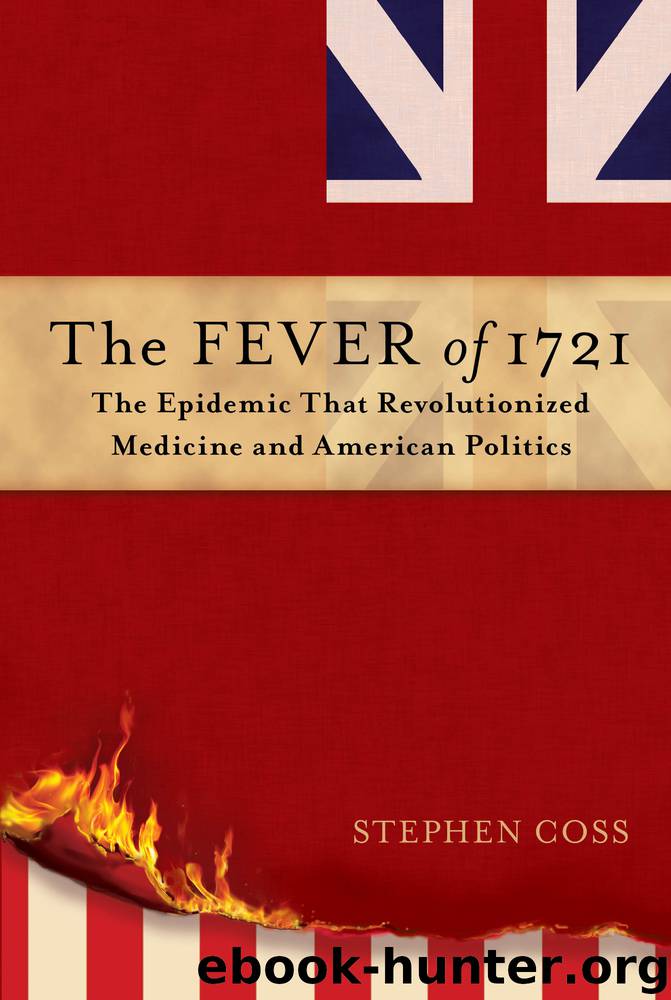The Fever of 1721 by Stephen Coss

Author:Stephen Coss
Language: eng
Format: epub
Publisher: Simon & Schuster
Published: 2016-04-23T16:00:00+00:00
18
POINTED SATYR
Late on the afternoon of December 2, 1721, several hours after what Samuel Sewall called “a great Funeral” for the deceased Boston politician William Hutchinson, a letter appeared at the Franklin printing house, where the proprietor and his apprentice were composing the next issue of the Courant.1 James would refer to it as “my Curse at Large.”2 An introductory note, written by someone who called himself “Castalio,” challenged the Courant to publish what followed, a supposedly full and true account of the confrontation between James Franklin and Cotton Mather on a Boston street three weeks earlier. The author was plainly Mather himself, whose diary entry for the day amounted to a single sentence: “Some very wicked Persons, must have suitable Admonitions dispensed unto them.”3
Along with the rest of pious, respectable Boston, Mather had been offended by the paper’s indecent treatment of marriage, and by its salaciousness and smirking impudence, its lack of proper respect for everything decent Bostonians held dear. What he resented most, though, was the mockery and satire it had directed at him and his father in the months since it had cut ties with John Checkley and repudiated the blunt-force assaults of its first several issues. On one occasion the newspaper had caricatured Mather’s sometimes hyperbolic support for inoculation by having an impersonator proclaim it a discovery “More Worth than a World!” and insist that “Never one dyed in this Way; and ’tis probable, more than probable; never will,” a fatuous boast made more so by its appearance soon after the death of Mrs. Dixwell.4 The Couranteers had also made sport of the specious reasoning Mather and his father had employed in their arguments for the procedure. At one point, for instance, Increase had asserted that since ministers and magistrates were wise and judicious, and since many ministers and magistrates were for inoculation, therefore inoculation was wise and judicious. Cotton had then chimed in, asserting that since inoculation was “a most successful and allowable Method of preventing Death,” it was not only “Lawful” but also mandatory; that man had “a Duty to make use of it.” With an imperiousness that begged for retaliation, he had added that only “very foolish, and very wicked People will deny the Proposition in this Argument.”5 Nathaniel Gardner’s response took the form of his own set of absurdly nonsensical syllogisms, one of which made comic fodder of both Mather arguments:
Arg. IV: A method of preventing Death, which the Known children of the Wicked One, are fierce Enemies to, is not only lawful, but a Duty. But the known Children of the Wicked One, do fiercely Oppose Inoculation. Therefore, it is not only lawful, but a Duty.6
The young men of the Courant were pointing their fingers at two of the most powerful religious figures in the history of Massachusetts and laughing. The effect had been to deepen and intensify Cotton Mather’s long-festering grudge against what three years earlier he had called a “wicked, stupid, abominable Generation; every Year growing rather worse and worse, under the Judgements of Heaven; drowned in all Impiety and Perdition.
Download
This site does not store any files on its server. We only index and link to content provided by other sites. Please contact the content providers to delete copyright contents if any and email us, we'll remove relevant links or contents immediately.
| African Americans | Civil War |
| Colonial Period | Immigrants |
| Revolution & Founding | State & Local |
Cat's cradle by Kurt Vonnegut(13868)
Pimp by Iceberg Slim(12931)
Underground: A Human History of the Worlds Beneath Our Feet by Will Hunt(11257)
4 3 2 1: A Novel by Paul Auster(11050)
The Radium Girls by Kate Moore(10907)
American History Stories, Volume III (Yesterday's Classics) by Pratt Mara L(4826)
Perfect Rhythm by Jae(4621)
Wiseguy by Nicholas Pileggi(4586)
The Fire Next Time by James Baldwin(4343)
Paper Towns by Green John(4169)
A Higher Loyalty: Truth, Lies, and Leadership by James Comey(4033)
Pale Blue Dot by Carl Sagan(4001)
The Mayflower and the Pilgrims' New World by Nathaniel Philbrick(3915)
The Doomsday Machine by Daniel Ellsberg(3731)
Too Much and Not the Mood by Durga Chew-Bose(3695)
Killers of the Flower Moon: The Osage Murders and the Birth of the FBI by David Grann(3609)
The Borden Murders by Sarah Miller(3590)
The Sympathizer by Viet Thanh Nguyen(3481)
Killing England by Bill O'Reilly(3455)
